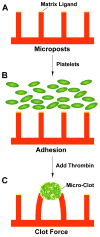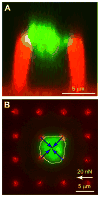Platelet retraction force measurements using flexible post force sensors
- PMID: 20358105
- PMCID: PMC4918627
- DOI: 10.1039/b918719g
Platelet retraction force measurements using flexible post force sensors
Abstract
Platelets play an important role in hemostasis by forming a thrombotic plug that seals the vessel wall and promotes vascular healing. After platelets adhere and aggregate at the wound site, their next step is to generate contractile forces through the coordination of physicochemical interactions between actin, myosin, and alpha(IIb)beta(3) integrin receptors that retract the thrombus' size and strengthen its adhesion to the exposed matrix. Although platelet contractile forces (PCF) are a definitive feature of hemostasis and thrombosis, there are few approaches that can directly measure them. In this study, we describe the development of an approach to measure PCF in microthrombi using a microscopic flexible post force sensor array. Quasi-static measurements and live microscopic imaging of thrombin-activated platelets on the posts were conducted to assay the development of PCF to various hemostatic conditions. Microthrombi were observed to produce forces that monotonically increased with thrombin concentration and activation time, but forces subsided when thrombin was removed. PCF results were statistically similar on arrays of posts printed with fibronectin or fibrinogen. PCF measurements were combined with clot volume measurements to determine that the average force per platelet was 2.1 +/- 0.1 nN after 60 min, which is significantly higher than what has been measured with previous approaches. Overall, the flexible post arrays for PCF measurements are a promising approach for evaluating platelet functionality, platelet physiology and pathology, the impacts of different matrices or agonists on hemostatic responses, and in providing critical information regarding platelet activity that can guide new hemostatic or thrombotic strategies.
Figures






Similar articles
-
Development of platelet contractile force as a research and clinical measure of platelet function.Cell Biochem Biophys. 2003;38(1):55-78. doi: 10.1385/CBB:38:1:55. Cell Biochem Biophys. 2003. PMID: 12663942 Review.
-
Delayed, reduced or inhibited thrombin production reduces platelet contractile force and results in weaker clot formation.Blood Coagul Fibrinolysis. 2002 Apr;13(3):193-7. doi: 10.1097/00001721-200204000-00004. Blood Coagul Fibrinolysis. 2002. PMID: 11943932
-
Nonmuscle Myosin IIA Regulates Platelet Contractile Forces Through Rho Kinase and Myosin Light-Chain Kinase.J Biomech Eng. 2016 Oct 1;138(10):1045061-4. doi: 10.1115/1.4034489. J Biomech Eng. 2016. PMID: 27548633 Free PMC article.
-
Superactivated platelets: thrombus regulators, thrombin generators, and potential clinical targets.Arterioscler Thromb Vasc Biol. 2013 Aug;33(8):1747-52. doi: 10.1161/ATVBAHA.113.301790. Arterioscler Thromb Vasc Biol. 2013. PMID: 23864724 Review.
-
Disorders of platelet function.Dis Mon. 1992 Aug;38(8):577-631. Dis Mon. 1992. PMID: 1321709 Review.
Cited by
-
A multiscale model for multiple platelet aggregation in shear flow.Biomech Model Mechanobiol. 2021 Jun;20(3):1013-1030. doi: 10.1007/s10237-021-01428-6. Epub 2021 Mar 29. Biomech Model Mechanobiol. 2021. PMID: 33782796 Free PMC article.
-
Blood clot contraction: Mechanisms, pathophysiology, and disease.Res Pract Thromb Haemost. 2022 Dec 23;7(1):100023. doi: 10.1016/j.rpth.2022.100023. eCollection 2023 Jan. Res Pract Thromb Haemost. 2022. PMID: 36760777 Free PMC article.
-
Contractile forces in platelet aggregates under microfluidic shear gradients reflect platelet inhibition and bleeding risk.Nat Commun. 2019 Mar 13;10(1):1204. doi: 10.1038/s41467-019-09150-9. Nat Commun. 2019. PMID: 30867419 Free PMC article.
-
The platelet and the biophysical microenvironment: lessons from cellular mechanics.Thromb Res. 2014 Apr;133(4):532-7. doi: 10.1016/j.thromres.2013.12.037. Epub 2014 Jan 4. Thromb Res. 2014. PMID: 24440140 Free PMC article. Review.
-
Microclot array elastometry for integrated measurement of thrombus formation and clot biomechanics under fluid shear.Nat Commun. 2019 May 3;10(1):2051. doi: 10.1038/s41467-019-10067-6. Nat Commun. 2019. PMID: 31053712 Free PMC article.
References
Publication types
MeSH terms
Substances
Grants and funding
LinkOut - more resources
Full Text Sources
Other Literature Sources

